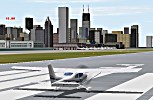Bruce Artwick
Read what the University of Illinois has
to say about her famous former student:
 |
Highlight
from Spring 1996 |
 |

Bruce Artwick is still flying:
and thanks to his software, many of us can too
Bruce Artwick, BS
EE'75, MS EE'76 is best known as the author of the landmark
program Flight Simulator, now in its fifth version, sold by
Microsoft. He is also founder of two successful companies:
SubLOGIC and BAO.
Before writing
Flight Simulator, Bruce Artwick was deep into computer
hardware, honing his skills in the basement of DCL (Digital
Computer Lab). From those depths, he rose from the earth to
the sky with Flight Simulator and, most recently, to faraway
galaxies with his latest creation, Space Simulator.
Artwick, a native of
Norridge, Illinois, attended Triton Junior College in River
Grove before coming to U of I to study computer engineering
in 1973. He switched to electrical engineering because he
thought that in those early days of computing, the EE degree
would be better understood by most people.
While he was a student,
Artwick applied his interest in aviation and did research at
the Aviation Research Lab while working as a technician in
DCL. In 1975-76, as a member of the graphics group headed by
Professor Bill Gear, Artwick designed graphics terminals in
DCL. His thesis work was on 3-D graphics for flight
simulation, and during the course of this work, he became a
pilot.
Artwick recalls the many
hours spent on the graphics terminals which he designed for
the UNIX system in DCL. "We had one of the first UNIX
systems in the country," said Artwick. "I worked
with Al Whaley [BS'74, PhD'84] and Greg Chesson [MS'75,
PhD'77] setting it up on the PDP 11, and I designed a lot of
the multiplexor plug-ins. Ken Thompson [original developer
of UNIX, from Bell Labs] was there." The multiplexors
allowed terminals to be directly hooked up to the PDP 11, an
early client-server system. Later on, Artwick designed parts
of the dial-in system that allowed remote users to connect
to the machine by 300-baud modem. "I learned more
working in the basement of DCL than in classes," he
said.
After graduation in 1976,
at the beginning of the microcomputer revolution, Artwick
went to work for Hughes Aircraft in Culver City, California.
Because Artwick understood how to write graphics routines
for microcomputers, and he knew the capabilities of their
microprocessors from his PDP 11 work, he figured that he
could do 3-D dynamic graphics on 6800-based machines as
well. Artwick wrote a program and a few magazine articles
about this idea. One of the magazine editors called Artwick
and asked him if he sold the program because some of the
readers wanted to buy it. So, Artwick founded his first
company, in Los Angeles in 1977, and called he it SubLOGIC.
The name was a reference to the logic circuits he had built
for the PDP 11 in DCL.
SubLOGIC's business
strategy was to sell their software by mail. In two years,
the business had grown substantially and Artwick was finding
Los Angeles to be too crowded for his liking. So he moved
part of the operation back to Champaign-Urbana with the
assistance of his flight instructor, Stu Moment, BS BusAdmin,
MBA'80. At that time, SubLOGIC was selling graphics packages
to run on machines like the Altair 8800 and Imsai 8080.
Customers were mostly computer hobbyists and scientific
people.
In January 1979, Flight
Simulator (FS) was launched for the Apple II. Then, as now,
most of the users of FS were not pilots themselves. SubLOGIC
continued to grow and came out with a number of different
versions of FS and other entertainment programs. Their
products were extremely popular on the Apple II, Commodore
64, and Atari 800, the home computers of the day. Early in
1982, FS became the top-selling software for Apple.
Artwick then got a call
from Microsoft. Microsoft was working with another company
that was coming out with a new computer that they predicted
would revolutionize the industry, and they wanted to put FS
on it to show off the machine's graphics capabilities. At
the same time, Artwick recevied a similar call from IBM. He
opted to work with Microsoft, and the new, revolutionary
computer turned out to be the IBM PC. Artwick figures he had
the first IBM PC in Champaign-Urbana. In November 1982, FS
became the first entertainment program available for the IBM
PC, and naturally it became a bestseller as well.
"Flight Simulator
pushed hardware to the limit," Artwick explained.
"PC designers used Flight Simulator as a benchmark for
PC compatibility." Artwick worked with Compaq on the
first PC clones, and in the process, actually found a bunch
of bugs in the IBM machines.
In the late 1980s,
SubLOGIC ran into hard times because the 8-bit market had
shifted to 16-bit, so Artwick left SubLOGIC and formed BAO
(Bruce Artwick Organization) to continue his FS work. The
market for FS had expanded to include products for the
Federal Aviation Administration, and BAO was producing other
aviation-related software for things like tower control
simulation for training air traffic controllers. BAO
employed about 35 people.
In addition to software
and technical papers, Artwick wrote several books, including
Microcomputer Displays, Graphics, and Animation
(Prentice-Hall, 1985), and Microcomputer Interfacing
(Prentice-Hall, 1980).
BAO's latest creation is
Space Simulator. It is reportedly the most advanced and
complex simulation program ever created for the PC, and with
it, the user pilots a spacecraft through the heavens.
Microsoft has been
marketing BAO products all these years, but in November
1995, Artwick sold the assets of BAO to Microsoft, and most
of the BAO staff moved to Seattle. SubLOGIC was purchased by
Sierra. Artwick and five employees remain at BAO in
Champaign, and Artwick plans to continue his simulator and
graphics work. He also enjoys flying real planes as well!

Comments to: alumni@cs.uiuc.edu
Published with permission of the University
of Illinois.

|

